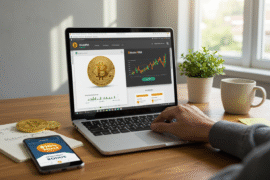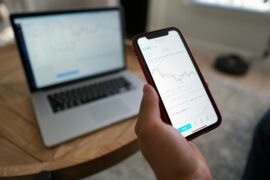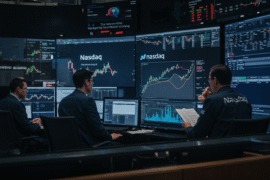This article may contain references to products or services from one or more of our advertisers or partners. We may receive compensation when you click on links to those products or services. Nonetheless, our opinions are our own.
The information presented in this article is accurate to the best of our knowledge at the time of publication. However, information is subject to change, and no guarantees are made about the continued accuracy or completeness of this content after its publication date.
In a world where economic uncertainties can dictate the flow of various industries, you might ponder the resilience of global payments. Even amid a mild recession rippled through markets and consumer behavior, how we transfer, receive, and manage money remains captivating. This might surprise you, but the realm of global payments has thrived, adapting and evolving in ways that showcase its intrinsic value. We’ll dive into how the landscape of international payments is not only holding its ground but also proving to be a fascinating area of study during these financially turbulent times. Join me as we explore the innovative technologies, emerging trends, and underlying principles that keep this sector relevant and essential, irrespective of economic challenges.
Exploring the Resilience of Global Payments Amid Economic Downturns
The global payments landscape always seems to possess a certain robustness, even during challenging economic phases. Despite a mild recession causing trepidation among consumers and businesses alike, the machinery of global transactions continues to function smoothly. You might find it intriguing that despite economic fluctuations, the digital payment sector has demonstrated remarkable adaptability, allowing consumers to shop online easily and businesses to pivot quickly to meet changing demands. Here are a few reasons why this resilience is noteworthy:
- Technological Innovation: With the rise of fintech solutions, conventional barriers to entry in the payments space are crumbling. New platforms and apps cater to diverse needs, making transactions easier and frequently more cost-effective.
- Consumer Preference Shift: The pandemic shifted shopping habits towards online and contactless payments, a persisting trend. Many consumers now prefer the convenience digital payments offer, even in a fluctuating economy.
- Global Connectivity: As economies become more intertwined, cross-border transactions continue to thrive, driving innovation in currency exchange systems and transaction speeds.
In evaluating the resilience of this sector, it’s also vital to consider the trends shaping its future. Below, you’ll find a snapshot of some critical factors driving the global payments industry during economic downturns:
| Factors | Impact on Global Payments |
|---|---|
| Digital Wallet Adoption | Increased transaction volume and customer retention |
| Cryptocurrency Integration | New opportunities for decentralized payments and investment |
| Regulatory Changes | Adaptation to compliance enhances trust in payment systems |
By staying informed and adapting to these changes, you can navigate this landscape successfully, leveraging new technologies and practices to support your financial goals even when confronted with economic uncertainty. Monitor innovations and trends, as they may equip you with the necessary tools to prosper in a dynamic financial environment.
Voted "Best Overall Budgeting App" by Forbes and WSJ
Monarch Money helps you budget, track spending, set goals, and plan your financial future—all in one app.
Get 50% OFF your first year with code MONARCHVIP
How Economic Trends Shape Your Global Payment Options
In today’s mild recession, understanding how economic trends affect global payment options is essential for any savvy individual looking to navigate their finances effectively. As you contemplate your payment preferences, be mindful of the dynamic landscape being shaped by factors like inflation rates, currency fluctuations, and international trade dynamics. These elements can greatly influence the ease and cost of cross-border transactions, often leading to varying fees or exchange rates that can impact your budgeting strategies.
To maximize your options, be sure to evaluate:
- Transaction Fees: Compare costs across different payment platforms and services.
- Currency Options: Choose services that offer favorable rates and minimal conversion fees.
- Geographic Coverage: Ensure your payment methods work seamlessly whether you’re at home or traveling abroad.
| Payment Method | Fees | Best Use |
|---|---|---|
| Credit Card | 1.5-3% per transaction | Everyday purchases |
| Wire Transfer | $25-$50 | Large international payments |
| Digital Wallet | Varies; often free | Peer-to-peer transactions |
| Cryptocurrency | Network fees apply | Decentralized transactions |
Being informed about these trends and understanding their implications will empower you to pick the best payment methods that align with your financial goals. Stay proactive, and don’t hesitate to adjust your strategies to make the most of your global payment capabilities.

Reviewed and edited by Albert Fang.
See a typo or want to suggest an edit/revision to the content? Use the contact us form to provide feedback.
At FangWallet, we value editorial integrity and open collaboration in curating quality content for readers to enjoy. Much appreciated for the assist.
Did you like our article and find it insightful? We encourage sharing the article link with family and friends to benefit as well - better yet, sharing on social media. Thank you for the support! 🍉
Article Title: Global Payments is Interesting Even With A Year Of Mild Recession
https://fangwallet.com/2025/03/03/global-payments-is-interesting-even-with-a-year-of-mild-recession/The FangWallet Promise
FangWallet is an editorially independent resource - founded on breaking down challenging financial concepts for anyone to understand since 2014. While we adhere to editorial integrity, note that this post may contain references to products from our partners.
The FangWallet promise is always to have your best interest in mind and be transparent and honest about the financial picture.
Become an Insider

Subscribe to get a free daily budget planner printable to help get your money on track!
Make passive money the right way. No spam.
Editorial Disclaimer: The editorial content on this page is not provided by any of the companies mentioned. The opinions expressed here are the author's alone.
The content of this website is for informational purposes only and does not represent investment advice, or an offer or solicitation to buy or sell any security, investment, or product. Investors are encouraged to do their own due diligence, and, if necessary, consult professional advising before making any investment decisions. Investing involves a high degree of risk, and financial losses may occur including the potential loss of principal.
Source Citation References:
+ Inspo
There are no additional citations or references to note for this article at this time.












































